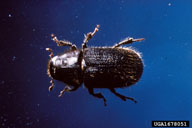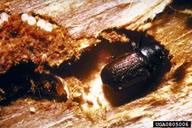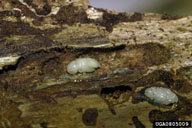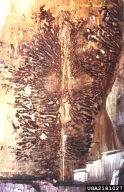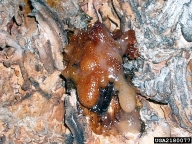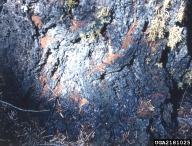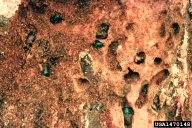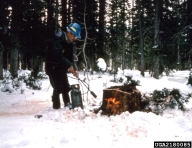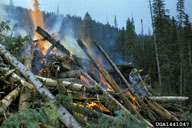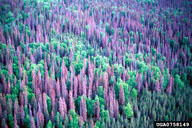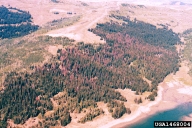Spruce beetle
Dendroctonus rufipennis (Kirby) (Coleoptera: Curculionidae, Scolytinae)
Orientation to pest
Spruce beetle, Dendroctonus rufipennis (Kirby), is a native North American bark beetle that usually develops in wind-thrown, over mature, or weakened trees, resources that normally occur at low densities in forests. The biology of the beetle is similar to that of many bark beetles, with females laying eggs in tunnels (egg galleries), from which larvae then begin to feed, forming larval galleries. In this species young larvae often feed in common galleries, but then produce individual galleries as they mature. Larvae pupate at the end of their galleries, and overwinter as either larvae or new adults in the galleries. Spruce beetles generally require two years to complete their life cycle. However, when temperatures are warmer than normal a generation can be completed in one year. When two years are required, development is not synchronized and beetles emerge and attack trees each year. Spruce beetle outbreaks are associated with warmer than usual weather, and are often triggered by disturbance events such as avalanches, storms, and logging. Outbreaks tend to occur in areas with an abundance of large spruce trees. Outbreaks occur several times each century, thinning large trees from stands over extensive areas. More severe outbreaks in which trees of most sizes and vigor classes are killed occur less frequently. Important outbreaks historically have occurred in Alaska and Utah.
Hosts commonly attacked
Spruce beetle attacks various species of native North America spruce (Picea)
Distribution
This bark beetle is found throughout the spruce forests of North America.
Images of spruce beetle
| Figure 1. Adult of spruce beetle, Dendroctonus rufipennis | Figure 2. Female spruce beetle digging an oviposition gallery, with white eggs visible in upper left | Figure 3. Spruce beetle larvae at ends of tunnels | Figure 4. Pupae of spruce beetle in galleries |
| Figure 5. Oviposition (vertical) and larval (horizontal) galleries of spruce beetle etched in wood under bark of spruce tree | Figure 6. Pitch tubes (left) and frass (right) on spruce trunks are signs of spruce beetle attack | Figure 7. Adult spruce beetles in galleries | |
| Figure 8. Burning of stumps (left) or logging slash (right) after felling infested trees is intended to limit spruce beetle outbreaks | Figure 9. Views of spruce trees killed by spruce beetle, at various physical scales (dead trees denoted in artificial color in left photo) | ||
Important biological control agents related to this pest species
A variety of natural enemies have been recorded in the literature attacking spruce beetle brood (see Van Driesche et al., 1996 in USDA FS publication FHTET-96-19, URL given below), including several species of braconid parasitoids in the genus Coeloides. Also the role of wood pecker predation on brood has been studied. But the fundamental determinants of outbreaks of spruce beetle do not seem to be driven by natural enemies, but rather to be responses to weather, the amount of breeding material for the beetle at a site, and local and regional spruce stand conditions.
Web links for information on spruce beetle
- Fact Sheet | Natural Resources Canada
- Forest Insect & Disease Leaflet 127 | USDA Forest Service
- FHTET publication | USDA Forest Service
See pages 55-57 for information on natural enemies of this species
Articles
- Schmid, J.M. and R. H. Frye. 1976. Stand ratings for spruce beetles. Res. Note RM-309. USDA Forest Serv., Rocky Mtn. Forest and Range Exp. Sta., Ft. Collins, Colorado. 4 pp.
- Schmid, J.M. and R. H. Frye. 1977. Spruce beetle in the Rockies. USDA Forest Service, Rocky Mtn. Forest and Range Experiment Station, General Technical Report RM-49. Ft. Collins, Colorado. 38 pp.
- Linton, D. A. and L. Safranyik, L. 1988. The spruce beetle Dendroctonus rufipennis (Kirby): an annotated bibliography 1885-1987. Information Report - Pacific Forestry Centre, Canadian Forestry Service (BC-X-298), 39 pp.
